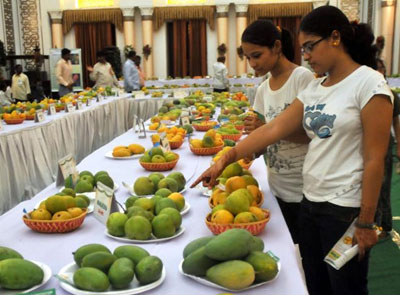 New Delhi:
New Delhi: Mangoes are in season and city residents can now feast on a delectable range of the fruit from West Bengal, at a 'Mango Mela' here.
Eclectic varieties of the king of fruits - Gulabkhas, Dilkhush, Amrapali, Langra, Fazli, Himsagar and Laxmanbhog - cultivated in various districts of the state, namely Malda, Murshidabad, and Bankura, have been brought here.
The West Bengal government inaugurated the third editon of the Bengal mango festival here last evening.
Krishnendu Narayan Chowdhury, Minister for Food Processing Industries and Horticulture of West Bengal government introduced the 'Amrapali,' a new mango variety that won several awards at a recent event in Kolkata.
Developed with help from the Bidhan Chandra Krishi Viswa Vidyalaya, this new variety is expected to be a huge hit among mango lovers.
"This Amrapali variety of mango will one day become as popular as the Alphonso," Debapriya Sarkar, a member of the Panchayat Department said.
"We planted 37,000 trees in the last four years under the 100 days program of the MNREGA and what you are seeing here is the result of that – a lot of care has gone into this and we are proud of our product," he said.
Babulal Mahato, a district nodal officer said, "Not long ago, Malda was the district that produced the best quality of mangoes."
Besides the 'Amrapali' another new variety 'Mallika,' from Bankura, whose red soil gives mangoes their distinct taste, is expected to take up that mantle.
Varieties like Fazli, Himsagar and Laxmanbhog have received coveted registration under the Geographical Indication (GI) Index. A GI is a name or sign used on certain products, which corresponds to a specific geographical location or origin.
Typically, such a name conveys an assurance of quality and distinctiveness essentially attributable to the fact of its origin in that defined geographical locality.
From the juiciest variety to the sweetest, the Mango Mela has brought 2.6 metric tons of mangoes in an effort to popularise the Bengal variety of mangoes and to promote the 'Mango Tourism', which is coming up in Gour, in the district of Malda, the biggest mango producer in the state.
"We plan to develop more such tourism in the years to come. One day, West Bengal will be known for its high quality mangoes outside the state as well just like the apples of Shimla and Kashmir," Tamash Ranjan Ghosh, an official from Tourism Department said.
There are also plans for private partnership for sale of the processed products, including jams and pickles at various outlets in Kolkata, he said.
While the temporary ban by the European Union on Alphonso variety of mangoes some time ago has been lifted, owners of mango orchards have taken special care not to spray pesticides once the first signs of the fruits appear.
A woman member of the Self Help Group program in Bankura, said, "Such is the taste of our mangoes that when we went to Kolkata, most people clamoured for them instead of traditional favourites like Himsagar and Langra. I feel proud to say that
these mangoes were first grown in my orchard."
Himsagar also known as Khirspati in Malda is probably the best-loved one of royal families is known for its unmistakable golden hue and becomes available from the second week of June to the end of the month.
Available from mid-June to 1st week of July, the Laxmanbhog has a radiating golden yellow skin with reddish tinge. They are fruits are with light sweetness and completely free from fibre.
Mature fruits of Langra are available till the end of June and are greenish yellow, firm and nearly devoid of fibre. Its sweet-and-sour flamboyance of flavour is full of rich promise of pleasure.
Brindabani is a sweet flavoured, early variety mango. Very thin skinned they are generally small, or average sized and has a good demand in the local market.
The Bharati mango has a thick skin and turns yellow at ripening and has a sweet pulp and low fibre. It is a mid-season fruit.
The Laxmibhog is a mid-season variety with very attractive reddish-yellow skin colour is moderately sweet and contains medium fibre with mild flavour.
The Gulabkhas is known for its very attractive reddish-yellow and bright skin while the Dilkhus are apple-shaped with very attractive yellow skin colour and very sweet pulp.
The Sitabhog mangoes are small, elongated and juicy whose skin turns yellow when ripe.
The Fazli is full of sweet mystery and with a lot of juicy pulp, and arrives usually at the end of June and continues up to end of July. A single mango weighs a kilogram or even more. Just a couple of them could serve as a full royal repast. The mango festival is scheduled to continue till July 5.
Under a collaborative effort with APJ Surrendra Group, Bengal mangoes will also be sold during the same period at an extension counter at the Connaught Place outlet of 'Oxford Bookstore-Cha Bar'.
Select handloom and handicrafts from Bengal, such as 'Nakshi Kantha' (traditional needle-craft) apparels, majestic Baluchari embroidered sarees, Shantiniketan embossed leather goods, terracotta costume jewellery, wooden masks and dolls, super-fine mats, hand-printed sarees, clay dolls, dokra craft as well as Bengali books will be on sale at Dilli Haat during the period.
The exposition also features a stall from the Agriculture Marketing and Tourism Departments of West Bengal.
 New Delhi: Mangoes are in season and city residents can now feast on a delectable range of the fruit from West Bengal, at a 'Mango Mela' here.
New Delhi: Mangoes are in season and city residents can now feast on a delectable range of the fruit from West Bengal, at a 'Mango Mela' here.